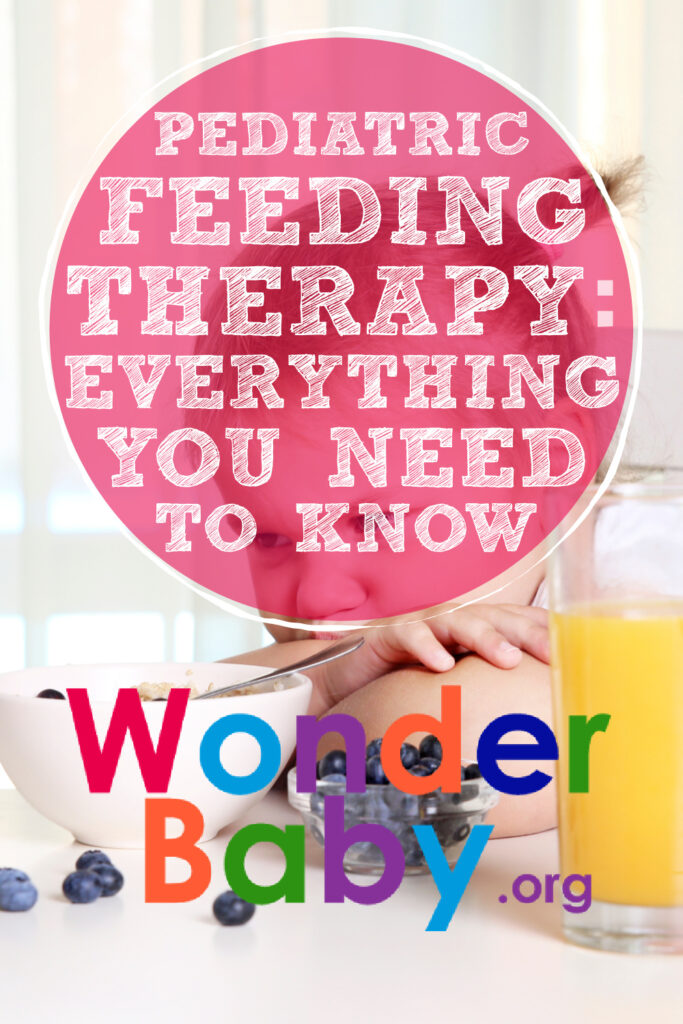Pediatric Feeding Therapy: Everything You Need to Know

- Pediatric feeding therapy helps children who have difficulties related to eating.
- There are several signs that your child might benefit from feeding therapy. Your child may have food aversions, difficulty with the physical aspects of eating, or struggle with mealtime routines.
- The therapy will be tailored to each individual’s needs. It may involve various techniques, such as oral motor exercises or independent feeding skills.
- The length of therapy will vary depending on your child’s needs. With consistent effort in sessions and at home, many children can make significant progress.
- Parents and caregivers are an important part of the therapy process.
I was labeled a “fussy eater” as a child, refusing certain tastes and textures. Thankfully, as an adult, my diet is broad and varied; for me, it just took a bit of encouragement and time. For others, early intervention may be needed to help them develop healthy eating habits.
This is where pediatric feeding therapy comes in.
Feeding therapy supports children with difficulties related to eating. This can include a selective diet, as well as other physical or emotional factors that are impacting their nutrition. Therapy sessions can drastically improve your child’s overall health and well-being.
Are you both leaving the dinner table frustrated? If you’re concerned about your child’s eating habits, it may be time to get support.
Feeding Therapy: What It Is and How It Works
Feeding therapy helps children with feeding and oral-motor difficulties. Typically, an occupational therapist or speech and language pathologist provides feeding therapy.
Therapists will try to establish what is causing your child’s feeding difficulties. They’ll start with a feeding evaluation and then develop a plan to address any areas of concern. This plan will look different for every individual but often involves:
- 1:1 therapy sessions working on specific feeding skills
- Techniques and tools, such as special spoons or cups
- Modifications to the child’s eating environment and routines
- At-home practice
Is Feeding Therapy for Picky Eaters?
Do you have a “picky eater”?
The term “picky eater” is often used to describe a child who has aversions to certain foods or textures. They might struggle to move on from purees or favor a more bland food palate. This is one of the many areas that a feeding therapist can support.
Picky eating may be an indicator of a sensory processing disorder. If you’re concerned, it’s worth highlighting to your pediatrician.

Benefits of Feeding Therapy
The goal of feeding therapy is for your child to develop healthy and effective eating habits.
Raj Manikam, MD, and Jay A. Perman, MD, note in Pediatric Feeding Disorders that “A majority of feeding problems can be resolved or greatly improved through medical, oromotor, and behavioral therapy.”
The benefits of this can span your child’s overall development. It ensures that they receive the nutrients they need to grow and thrive, but it can also support their social and emotional well-being.
It can be pretty frustrating for you and your child to engage in a battle every mealtime. Feeding therapy can support this and help your child to form positive associations with food and participation in family mealtimes.
How Long Does Feeding Therapy Last?
Every child is different and will respond differently to pediatric feeding therapy techniques. For some children, a few sessions may be able to address a specific feeding issue. Others may need more time and require ongoing therapy.
Your child’s feeding therapist will work alongside you to create a tailored therapy plan. It’s important to be patient and let your child progress at a pace comfortable to them.
When to Consider Feeding Therapy for Your Child
If you have any concerns at all about your child’s eating habits, it’s a good idea to speak to your child’s pediatrician. They can recommend if your child would benefit from a full feeding evaluation.
Some signs that your child may benefit from feeding therapy include:
- Poor growth or difficulty gaining weight
- Difficulty swallowing, chewing, or controlling saliva
- Frequently coughing, choking, gagging, or vomiting
- Refusal to eat or difficulties engaging with food and mealtimes
- Born with a medical condition that affects eating or developed difficulties due to a medical problem, such as cerebral palsy, cleft palate, and gastroesophageal reflux disease (GERD)
What Skills are Taught During Feeding Therapy?
There are a variety of skills that your child might work on during feeding therapy. Some of the common skills addressed include:
- Food tolerance: Accepting new foods and textures.
- Oral motor skills: Strengthening the muscles needed for chewing and swallowing.
- Independent feeding skills: For example, using cutlery or drinking from a cup.
- Posture while feeding.
- Fine motor or gross motor skills associated with eating.
- Positive mealtime associations.
- Social, communicative, and interaction skills associated with mealtimes.
A full assessment before therapy begins will determine which goals you and your child would like to work towards. For some children, this may be just one or two skills, whereas for others, there may be a number of milestones to work towards.

What Role Do Parents and Carers Have in Feeding Therapy?
Parents and caregivers are a vital part of the feeding therapy process. It’s important that the skills practiced in therapy are transferred to your child’s home environment.
These are some ways that you can support the therapy process:
Engage in Therapy Sessions
Work closely with the therapist to ensure the plan is tailored to your child’s needs. You know your child best!
Practice, Practice, Practice!
Provide opportunities for your child to use the skills learned in therapy at home. If you’re unsure how to do this, ask your therapist for guidance.
Communication With the Therapy Team
Share any observations from home. It is also important to advocate for your child’s needs, particularly if they have limited communication.
Increase Family Mealtimes
In Physiology & Behavior, Blake L. Jones, PhD, lists several benefits of shared family dinners. It can be tricky to find a mutual time you can all get around the table, but try to find opportunities where possible.
Have Patience
Feeding therapy can take time, so try to be patient and encouraging! Praise any progress you notice, such as your child trying new foods.
Model What You Want to See
When your child sees the entire family having a positive eating experience, it can encourage them to do the same.
One study by Sigrun Thorsteinsdottir, MD, PhD, et al. notes that “Parental feeding behaviors play a critical role concerning young children’s food preferences and health.” Aim for a stress-free feeding environment and show your enjoyment when you eat vegetables!
It can also be helpful to have some products to hand that make mealtimes less stressful. We’ve rounded up some favorite mealtime products for when it’s time to eat!
FAQs
How can you get kids to eat healthy foods that they don’t like?
It can be so frustrating trying to ensure your child is getting all of the nutrients they need to stay healthy if they refuse to put them in their mouths!
Luckily, there are some helpful strategies to encourage your child to try new and healthy foods:
- Offer a small amount of the new food with foods you know your child readily enjoys.
- Involve your child in the process. This might mean they help with meal planning, grocery shopping, meal preparation, and cooking. If you grow your own vegetables, even better! I find that my child is much more interested in trying a food he’s helped to bring to the plate.
- Keep trying! Did you know it can take ten exposures to a new food before your child accepts it? If they don’t like a food straight away, offer it again in a different meal.
- Try cutting foods into fun shapes. Who wouldn’t want to eat a monster face made of strawberries or a cucumber caterpillar?
- Teach the whole concept by learning about food and where it comes from.
What causes picky eating and feeding difficulties in children?
There are a variety of factors that may contribute to a child’s difficulties with food.
Manikam and Perman explain that “overwhelming evidence indicates that abnormal feeding patterns are not solely due to organic impairment.” Therefore, it may be considered “on a continuum between psycho-social and organic factors.”
Children often start with a physical reason for resisting food, which then leads to behavioral avoidance. They learn that eating is hard or doesn’t feel good.
A feeding therapy team can help you to understand the root cause of your child’s feeding difficulties and work with you to address those issues.
Do all children on the autistic spectrum struggle with food?
Some research shows that feeding disorders are more common among children identified with autism spectrum disorder. This does not mean that every child with autism will experience feeding difficulties.
For children with hypersensitivity to qualities such as textures, mealtimes can provide a sensory overload and be difficult to manage. Feeding therapy is key to helping your child in this scenario. Hsun-Chin Chao, MD, concludes, “the poor feeding behaviors of children with ASD can be minimized if addressed early and appropriately.”

The information WonderBaby provides is not intended to be, and does not constitute, medical or other health advice or diagnosis and should not be used as such. Always consult with a qualified medical professional about your specific circumstances.
Related Posts

Development, Special Needs
How to Track Milestones for Developmentally Delayed Babies
Parents of developmentally delayed babies can explore practical tools and strategies to track milestones, celebrate progress, and support their child’s unique developmental journey.

Fine and Gross Motor
5 Alternatives to Tummy Time for Babies with Motor Development Challenges
Does your baby struggle with tummy time due to motor development challenges? These alternatives to tummy time will offer the same benefits.

Development
Should Twins Share a Room?
Wondering if your twins should share a room? We’ll explore the pros and cons of room-sharing for twins right here before you make your decision.